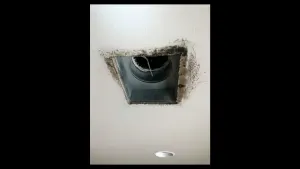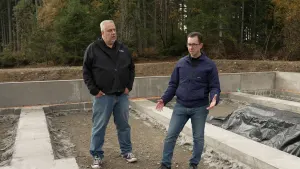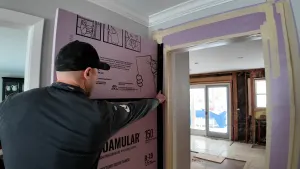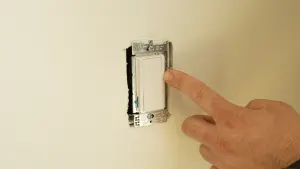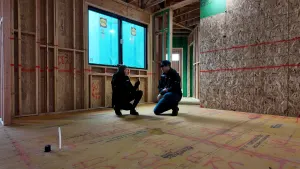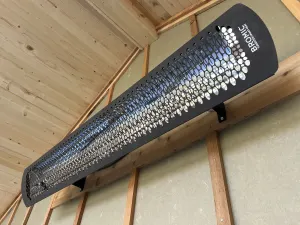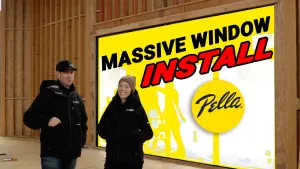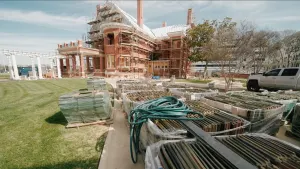When you frame a house, the 2×4 studs provide tremendous strength to the forces pulling straight down on the house, but the structural sheathing used on the outside is what resists the racking forces placed on the house from wind. When I first worked for a production builder out of college we used Thermoply which felt like structural cardboard. In my opinion this is not a building material that should be used for sheathing. So, your choices for structural sheeting are basically Plywood or Oriented Strand Board (OSB).
 |
| OSB Sheathing |
 |
| OSB Being Produced |
I saw a great quote on GreenBuildingAdvisor.com from one of my favorite building science teachers Dr Joe Lstiburek regarding this ago old question of which sheathing to use.
 |
| Plywood Sheathing viewed from inside the house |
“There is a big difference between OSB and plywood. Both have variable permeance, but the vapor permeance of plywood is more variable at the high end of the relative humidity scale. In the same microclimate, plywood works significantly better than OSB. Plywood dries much faster, while OSB needs to be more protected than plywood. OSB can’t get as wet and it needs to be more deliberately dried. That’s why it is critical to have an air gap between OSB and your cladding. Fiber-cement siding can go directly over plywood, but with OSB you need an air gap.”
There is a lot to unpack in the short quote.
#1 Vapor permeance: This is talking about the ability for water vapor to transport through the sheathing. In our hot/humid Austin climate we want to stop all the vapor drive at the Weather Resistive Barrier so that the OSB/Plywood won’t be subjected to water (liquid OR vapor). OSB actually does a better job at this than plywood. This is mainly due to the amount of glue used in making OSB. If you look at that photo above where the OSB is being produced you’ll see that each sheet is made up of thousands of tiny flecks of wood pressed and glued together. I suspect that this low perm rating has actually helped my houses in the past from issues related to vapor drive.
#2 Drying ability: It’s been my experience that OSB works as sheathing very well, but it really needs to be 100% protected from moisture (mainly bulk water). Once it gets wet and it’s not able to dry due to reduced air flow (as are all insulated stud bays) it’s really hard to get it to dry and stay structurally sound. I’ve also seen a lot more mold growth on OSB than I have on Plywood from the houses I’ve remodeled. This is explained because mold prefers the most broken down form of cellulose it can find. Plywood is made from peeling logs to form veneers that are glued together cross grain to form plywood. It’s basically solid lumber that’s really thin and glued together. OSB is essentially small flecks of wood and is therefore easier for the mold to eat. It’s closer to paper than solid wood.
I’ve used a lot of OSB over the years. My framer likes OSB because it’s ultra-consistent and easy for him to handle at the job site. It’s also typically less expensive than Plywood. This is the real reason you see OSB on 99% of the custom houses framed in Austin TX. Most of the production builders are using Thermoply for the same reason, it’s way cheaper than OSB. The commodity price of OSB in the last 5 years has been a low of $5/sheet to a high of $25/sheet. Currently (6/18/12) OSB is running about $10/sheet for 7/16″ thick and CDX Plywood 1/2″ thick is about $17/sheet. A typical 3000 sf house might use 150 sheets for exterior sheathing so this price difference isn’t insignificant. It can easily run $1000 more per house to use plywood compared to the less expensive OSB.
In conclusion, if you have the budget and the choice Plywood is the preferred sheathing to use. OSB isn’t terrible and your house won’t fall down because it’s sheathed with OSB, but in my opinion Plywood is the better choice. -Matt Risinger Risinger Homes Austin, TX

 Share on facebook
Share on facebook Tweet
Tweet Email
Email Share on Linkedin
Share on Linkedin




